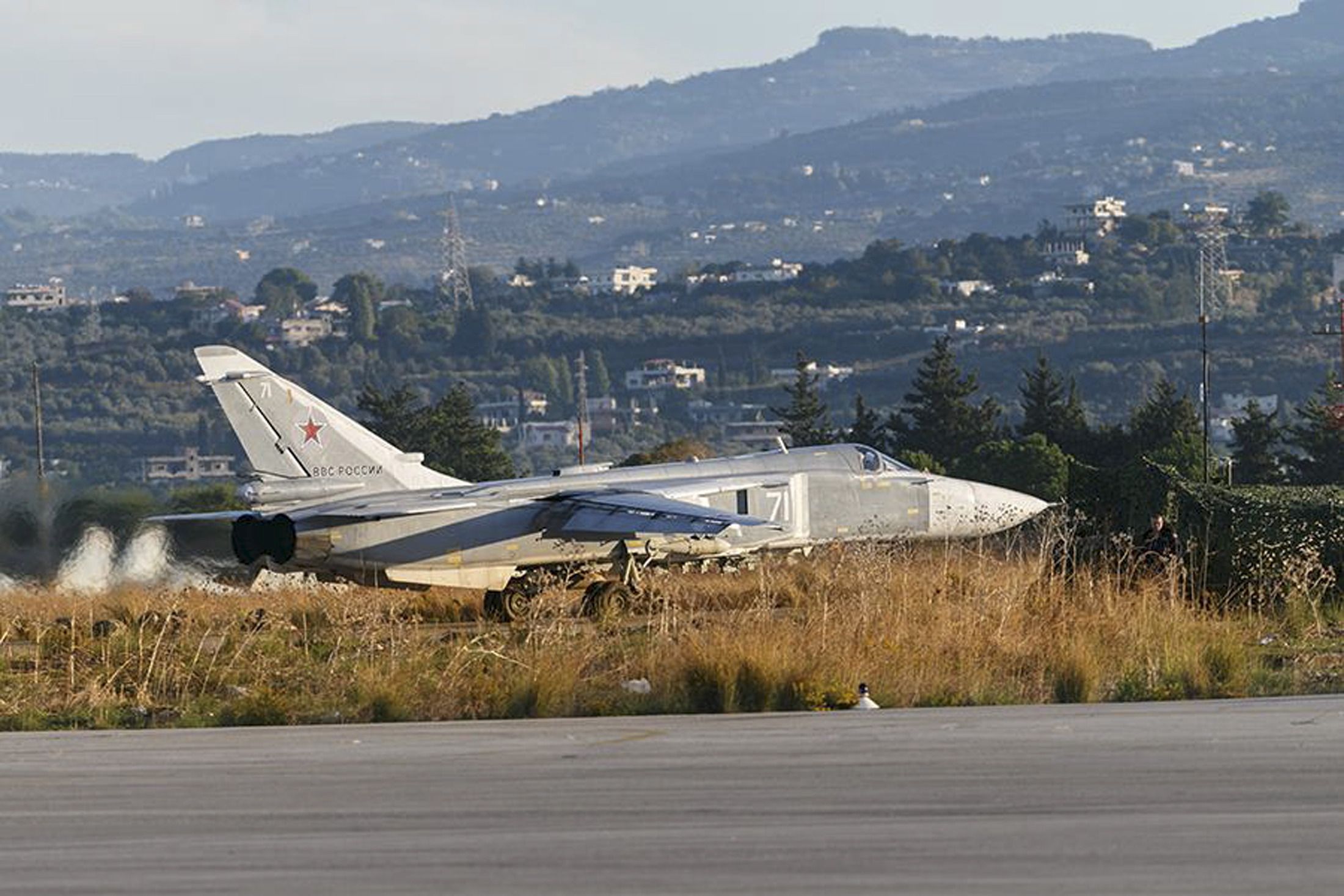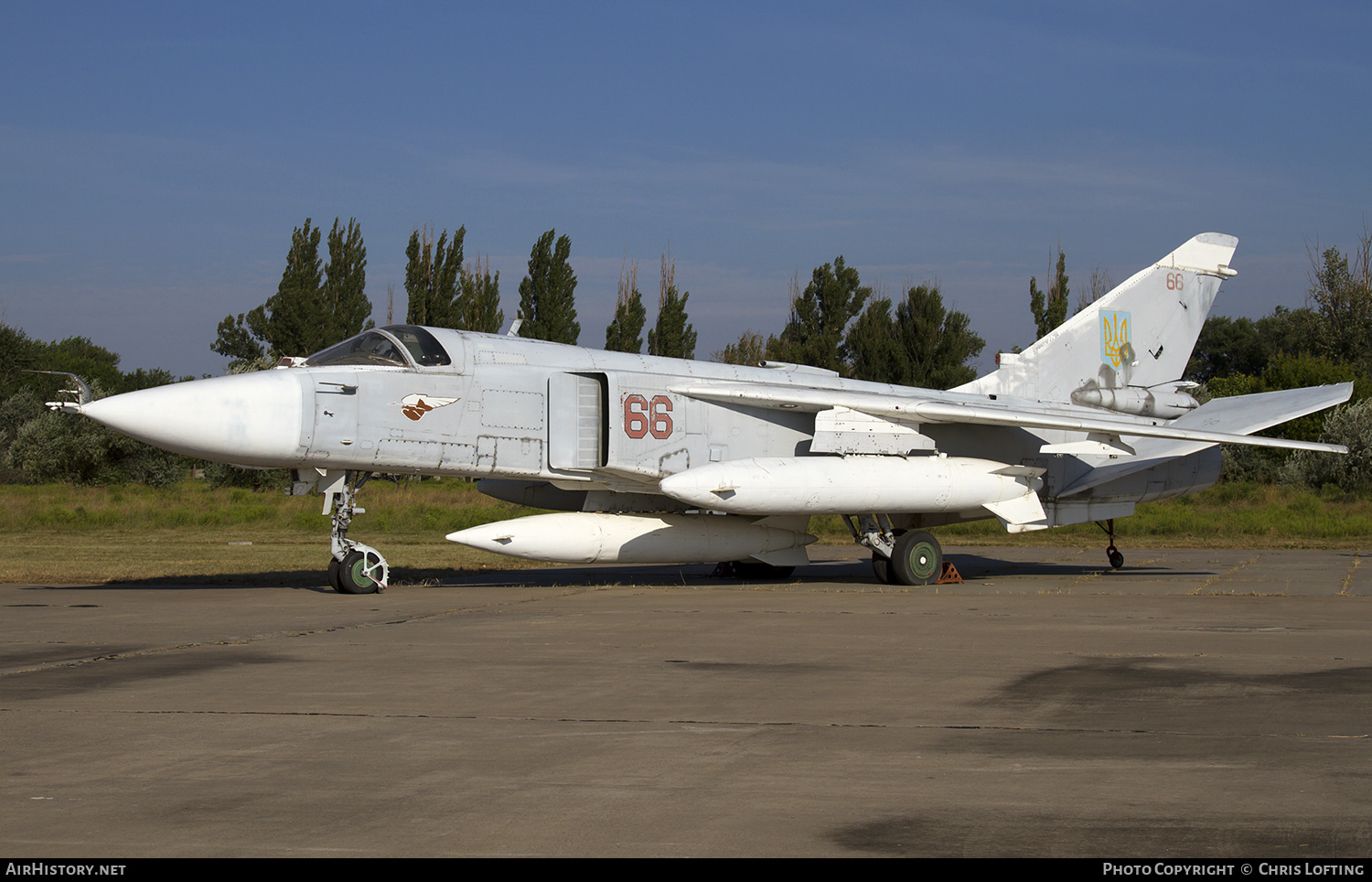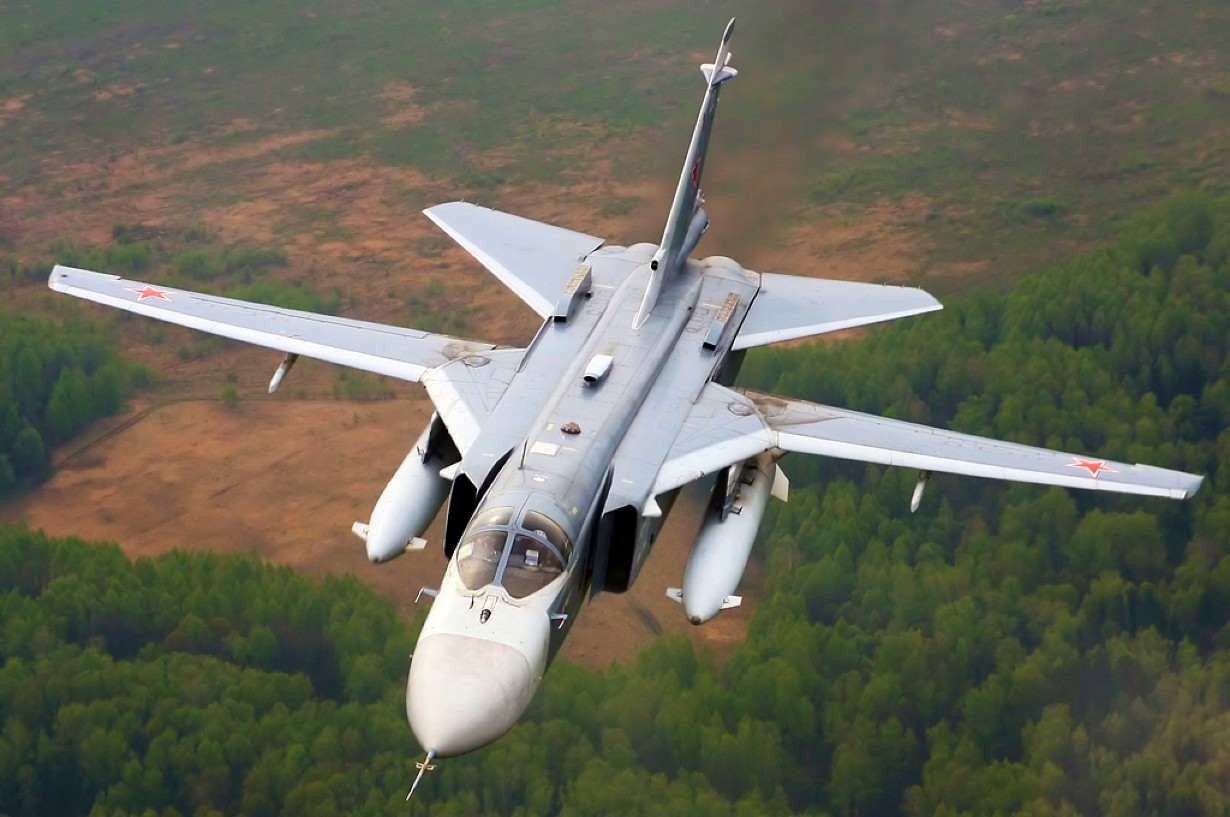Sukhoi 24 Jet - The main part of this article can be summarized to adequately summarize the main points. Expand the front page to provide an accessible overview of all key features of the article. (June 2022)
The Sukhoi Su-24 (NATO reporting name: Fcer) is a supersonic, all-weather fighter aircraft developed in the Soviet Union. The aircraft has a variable-sweep wing, twin-gin and side-by-side seating arrangement for its two crew members. It was the first Soviet aircraft to carry an integrated digital navigation/attack system.
Sukhoi 24 Jet

It is in service with the Russian Air Force, Syrian Air Force, Ukrainian Air Force, Algerian Air Force and various air forces to which it is exported.
This Is The Russian Plane That Turkey Just Shot Down
One of the conditions for commissioning the Sukhoi Su-7B in 1961 was that Sukhoi wanted to develop an all-weather variant capable of performing precision air strikes. Early tests with S-28 and S-32 aircraft revealed that the initial Su-7 design was too small to contain all the aircraft required for the mission.
The core of the new aircraft was tasked with developing an advanced navigation/attack system codenamed Puma.
In the same year, the American proposal for their new all-weather fighter was the TFX. The resulting F-111 would introduce a variable-geometry wing for greatly increased payload, range and low-level penetration capabilities.
In 1962-1963, Sukhoi initially worked on an aircraft without moving wings like the F-111. It designed and built the S-6 delta wing aircraft powered by two Tumansky R-21 turbojet engines. The mockup was tested but no further work was ordered due to lack of improvement in Puma hardware.
Video Shows Ukrainian Air Force Su 24mr Fencer Buzzing The Flight Line At An Airbase In Ukraine
In 1964, work began on the Sukhoi S-58M. The aircraft represented a replacement for the Sukhoi Su-15 interceptor (factory designation S-58). Meanwhile, the Soviet Air Force's revised requirements called for a STOL-capable low-altitude fighter. The ability to travel at supersonic speeds for extended periods of time at low altitudes is a key feature of the MM to overcome air pressure.
To achieve this, the design included two Tumansky R-27 afterburning turbojets for cruise and four Rybinsk RD-36-35 turbojets for STOL performance. Because the large Orion radar antennas required a large frontal cross-section, side-by-side seating for the crew was implemented.
To test the six-gin program, the first Su-15 prototype was converted to the S-58VD flying laboratory, operating from 1966-1969.

The aircraft was officially approved on 24 August 1965 under the internal designation T-6. The first prototype, the T-6-1, was completed in May 1967 and flew on July 2 with Vladimir Ilyushin at the controls.
Footage Shows Ukrainian Su 24 That Crashed Early In War With Russia
Initial flights were made in October 1967 with four lift jets installed. At the same time, the R-27s were replaced with the Lyulka AL-21F. STOL tests confirmed data from the S-58VD, resulting in poor short-field performance due to the elevator gene taking up space normally reserved for fuel, loss of hardpoints under the fuselage, and a significant loss of flight distance due to instability during the transition from STOL. That took a regular flight.
By 1967, the F-111 had reached the end of its service life and demonstrated practical advantages and solutions to the technical problems of the swing-wing design. On August 7, 1968, the OKB was officially tasked with researching a variable geometry wing for the T-6. As a result, the T-6-2I first flew under control with Ilyushin on January 17, 1970. Subsequent government experiments lasted until 1974, dictated by the complexity of internal systems.
Thanks to the Puma Nav/Attack system with two Orion-A superimposed radar scanners, Orbita -10- a relief ground clearance radar and Orbita -10- dedicated to the automatic control of aircraft at low and very low altitudes in the Soviet tactical fighter. 58 internal computer.
The crew was equipped with Zvezda K-36D ejection seats, which allowed them to bail out at any altitude and airspeed, including during takeoff and landing.
Russian Su 24 Bomber Jet Crashed In The Rostov Region
With a range of 3,000 kilometers (1,900 mi) and an 8,000 kg (18,000 lb) payload, the design was slightly smaller and had a shorter range than the F-111.
T fatal crashes occurred during Su-24 development, killing three Sukhoi and Soviet Air Force test pilots, followed by an average of 5 crashes per year.
The first production flight took place on December 31, 1971 at V.D. Vylomov remained in control and on February 4, 1975, the T-6 officially entered service as the Su-24.

Surviving Su-24M models have gone through a life extension and upgrade program with GLONASS, multi-function displays (MFDs), HUD, digital motion map generator, shell helmet-mounted displays and an advanced cockpit with the latest guidance. R-73 (AA-11 'Archer') Weapons including air-to-air missiles. The upgraded aircraft is designated Su-24M2.
File:sukhoi Su 24 Fencer 15 White (8602808235).jpg
This section requires additional citations for verification. Please help improve this article by adding citations to reliable sources. Unsubstantiated material may be challenged and removed. (February 2010 ) (Learn how and how to remove this template message)
The Su-24 has a shoulder-mounted variable geometry wing outboard with a relatively small fixed wing arm swept at 69°. The wing has four sweep settings: 16° for takeoff and landing, 35° and 45° for cruising at different altitudes, and 69° for minimum aspect ratio and low wing area. The variable geometry section provides excellent STOL performance, allowing landing speeds of 230 km/h (140 mph) faster than the Sukhoi Su-17. Its high wing loading provides a stable low-level ride and low aerodynamic response.
The Su-24 is powered by two Saturn/Lyulka AL-21F-3A afterburner turbojet engines with a thrust of 109.8 kN (24,700 lbf), air is fed from two rectangular side-mounted intakes with splitter blades/boundary-layer rotors.
The original Su-24 ("Fcer A" according to NATO) aircraft had variable slopes, a maximum speed of 2,320 km/h (1,440 mph), Mach 2.18, an altitude and ceiling of 17, m. 500 (57,400 ft). As the Su-24 is used almost exclusively for low-level operations, the actuators were removed for variable approaches to reduce and maintain weight. This did not affect low-level performance, but absolute maximum speed and altitude were reduced to Mach 1.35 and 11,000 meters (36,000 ft).
Sukhoi Su 24 Nato Name: Fence). Su 24 Of...
The early Su-24 had a box-like rear fuselage, which was quickly changed during production to have a rear exhaust shield that was shaped more closely around the gin to reduce drag. The revised aircraft received three antenna fairings on either side of the nose, relocated brake skirts and a new ram-air inlet at the base of the tail fin. The revised aircraft was designated "Fcer-B" by NATO, but did not qualify for the new Soviet designation.
The Su-24's loaded armament is a rapid-fire GSh-6-23 cannon with 500 rounds of ammunition mounted on the underside of the fuselage. The gun is covered by a blind shutter when not in use.
Although basic Su-24s have basic electronic countermeasures (ECM) equipment, most Su-24s are limited to the old Sira radar-warning receiver and lack any integrated jamming system. Later production Su-24s have more elaborate radar warning, missile-missile warning and active ECM equipment and triangular antennas on the sides of the intakes and on the tips of the vertical fins. It received the NATO designation "Fcer-C", but again had no separate Soviet designation. Some "Fcer-C" and later Su-24M (NATO "Fcer-D") have integrated flaps/flame spreaders in the large wing fce/pylons and wing glove compartment; Others have such launchers drilled on either side of the tail fin.

Kazakhstan, Russia and Ukraine have a significant number of ex-Soviet Su-24s in service. In 2008, approximately 415 were serving in the Russian Armed Forces, 321 in the Russian Air Force, and 94 in the Russian Navy.
Su 24 Bomber Crashes In Urals, Pilots Eject — Command
The Soviet Union used several Su-24s during the Soviet–Afghan War, with the initial round of strikes in 1984 and the second intervention in the 1988 war. The Su-24 lost nothing.
On October 13, 1990, Syrian Air Force jets entered Lebanese airspace to attack General Michel Aoun's forces. Sev Su-24 was used for this mission.
During Operation Desert Storm, the Iraqi Air Force transferred 24 of its 30 Su-24MKs to Iran. Five more were destroyed on the ground, and the only survivor remained in service after the battle.
In 1992, Uzbek Air Force (UzAF) Fcers were used against the United Tajik Resistance operating from Afghanistan (which was in its own civil war) as part of a wider air campaign in support of the Tajik government. -97 Civil War. A Su-24M with FIM-92 Stinger MANPADS fired by fundamentalists was shot down on May 3, 1993. Both Russian crew members were rescued.
Turkey's Defense Minister Hulusi Akar Personally Congratulated Pilot Who Downed Russian Su 24 Jet
In August 1999, a strike by four UzAF Su-24s against Islamist militants near two mountain villages in Tajikistan's Zhirgatol district killed about 100 cattle and burned several crops, although there were no casualties. Tashkt charges died.
During the final phase of the 1996–2001 Afghan Civil War, Uzbekistan conducted airstrikes against Taliban positions in support of the Northern Alliance. A UzAF Su-24 was shot down on June 6, 2001, killing both crew members while on a mission to attack a Taliban armored infantry unit near Heratan.
On the 3rd of February

Sukhoi business jet, sukhoi supersonic business jet, sukhoi passenger jet, sukhoi jet fighters, sukhoi su 24 fencer, sukhoi 30 jet fighter, sukhoi su 24, sukhoi 30 jet, sukhoi 24, sukhoi jet 100, jet sukhoi, sukhoi private jet

0 Comments